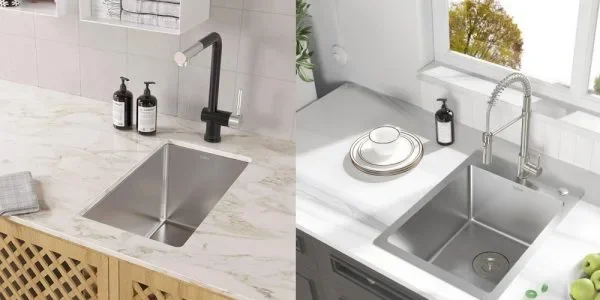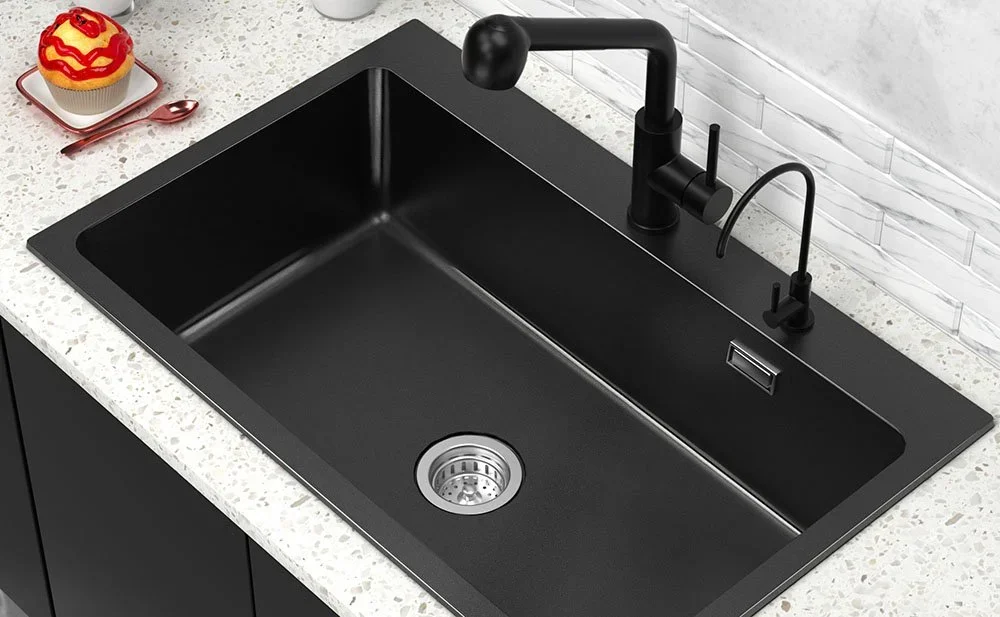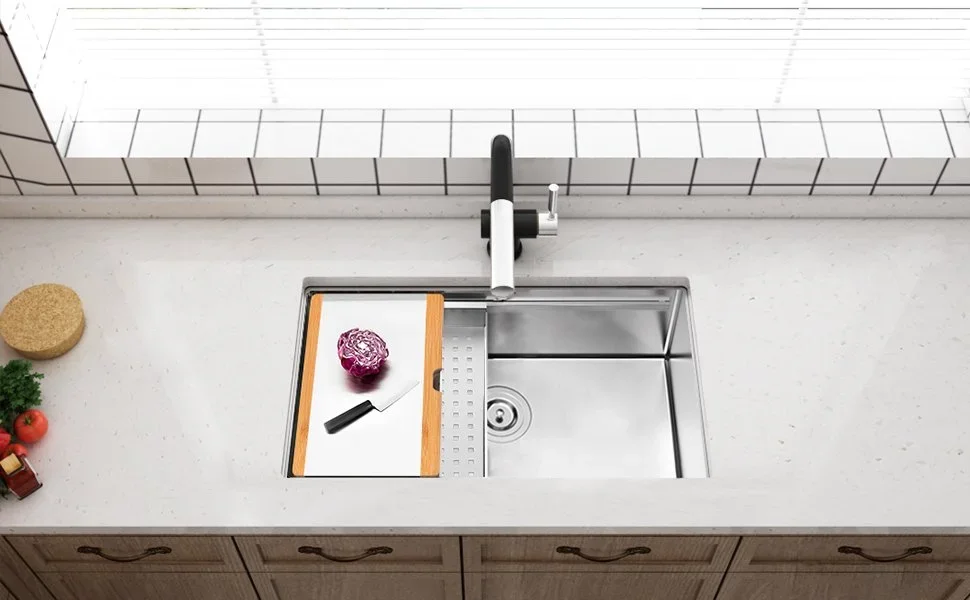Everyone imagines and expects to live in his own dream house and strive for that. Designing your dream house can be challenging, and managing the process can make your visions a reality. Modern and creative architectural designs have taken the place of old-fashioned layouts. Nowadays, people plump for modish and exquisite home designs ornamented with aesthetic and luxurious furniture and appliances.
The kitchen is an important area of the house, and it is appropriate to refer to it as the “heart of the home.” Like other sections of the house, you also want your kitchen to look appealing and elegant. No doubt, counter space, and luxurious appliances make your kitchen more enchanting and stylish; the sink is also a significant component to be considered.
Choosing the right sink is crucial whether you’re constructing a new kitchen or remodeling an old one. We usually neglect this part, but this is the place where we start preparing food and cleaning up after finishing our meals.
When you decide to shop for a sink, it can be overwhelming because of the large variety available in the market. Even if you have considered all the ins and outs, colors, finish, matching appliances, you will still be left behind with many styles and designs.
It would be best if you did not get worried as we will focus on the two popular types of sink – undermount and drop-in sinks – that will narrow down your checklist for choosing the right sink for your kitchen. Once you have decided which suits you best, opting for matching countertop and appliances will be an easy task.
Choosing between an Undermount Sink or Drop-in Sink
Undermount sinks and drop-in sinks are two famous sink categories used in kitchens. Both of these sinks have their benefits depending upon your requirements. They are sleek and graceful and available in several designs, making it flexible for you to choose the right sink. Before purchasing a sink, consider many things, including size, depth, material, etc.
Drop-in sinks have been in use for a long time and do not require much effort for installation. In contrast, undermount sinks started gaining popularity when solid countertop materials became famous. At first, undermount sinks were expensive and required a lot of effort to install compared to drop-in sinks.
No matter how graceful and elegant it might look, it does not fit all countertops. Undermount sinks can be loved for their looks, but you cannot ignore the long life of drop-in sinks for certain countertop materials like wood.
Let me ask you a few questions. Are you looking for a smooth and sleek kitchen sink? Going for an undermount sink looks like a better option. Or do you prefer functionality over charms? Getting a drop-in sink will do the trick. Whatever option you are considering, you must go through all the ins and outs, pros and cons, cost and maintenance, and installation procedures of both the sinks before you buy them.
Drop-in Sinks
Drop-in sinks are installed and rest on your counter, also known as self-rimming, overmount, and top-mount sinks. They are the most common type of sinks with a visible lip or rim that moves along the perimeter of the sink and rests flat on the cut-out space for the sink on your countertop. The sink basin fits into the hole, and the rim holds it in place.
Drop-in sink cabinets are installed by lowering them from the top of the sink cabinet into a hole carved out of the countertop. Stainless steel drop-in sinks are most popular. Other materials include stone, cast iron, copper, ceramic, etc. Metal clips are buried beneath the countertop to secure some drop-in sinks.
There are many varieties available for drop-in sinks. The double basin is the most popular type, followed by the ever-economical single basin. You can also opt for a three-bowl sink if you need more space.
Pros and Cons of Drop-in Sinks
Sinks placed into a recess and subsequently secured are known as drop-in sinks. This installation method is basic and straightforward, making it out of almost any material. Because the drop-in sink was previously the only option, it comes in various sizes and forms.
It may be fashioned of practically any traditional sink material, such as stainless steel, enameled cast iron, ceramic, porcelain, stone, and engineered stone. Here are a few advantages why you might prefer a drop-in sink to an undermount sink.
Pros:
- Cheap and Affordable: Drop-in sinks are economical, less costly, and easy to install. When looking for a manufacturer that sells both undermount and drop-in sinks, you’ll see that the drop-in sink is less expensive than the undermount.
- Easy to Install: Drop-in sinks are simple to install since they slot into the countertop and rest on top of it. Furthermore, they are generally easier to install than other types of sinks.
- Availability and Versatile: Drop-in sinks are versatile and available in different colors, sizes, styles, and materials and can also be customized according to your requirements.
- Compatibility: Drop-in sinks are compatible with various countertop materials, including laminate, tile, solid surface, composite, and natural stone.
Cons:
- Take more counter space: Drop-in sinks take up more counter space than undermount sinks because they have a visible rim that rests on the counter.
- Hard to clean: Because the sink’s rim protrudes from the countertop, cleaning around the edges or lip can be difficult, as food can become caught or wedged in the area between the sink and the countertop.
- Require heavy countertops: Even though drop-in sinks are designed to support their load, they are nevertheless large and heavy. They also require strong, hard, and hefty counters to sustain them because they sit on top of the counter.
Undermount Sinks
Undermount sinks get their name because they lie beneath the counter, with the sink’s border below the countertop’s level. Undermount sinks appeal to people for more than just aesthetic reasons. Except for the bigger ones that are hard to sustain, they are made of the same materials as drop-ins. The seamless look is one of the reasons why so many people choose undermount sinks for their kitchen remodels.
The sink’s lip is flush against the countertop since it is mounted beneath the counter. This results in smooth, continuous lines ideal for stylish or modern decor. The faucets on the sink can also be mounted on the wall for a unique design. Your family and visitors will focus on the other decor in your home if the eye isn’t drawn to the sink in your room. Attract their attention to the textures, colors, or minor works of art that you enjoy.
Undermount sinks are attached to the underside of the countertop with heavy-duty hooks and cement or special glue. Although an undermount sink has a rim, it is not evident because it is parallel with the counter’s base. The countertop edge along the sinkhole is completely exposed. As a result, solid countertop materials such as solid surface, natural stone, or quartz are required when using undermount sinks.
Pros and Cons of Undermount Sinks
Undermount sinks add a lot of visual appeal to any kitchen. Because of the way they’re installed, they’re hidden from view, making the rest of your kitchen look more appealing. In addition to the benefits that an undermount sink can provide, it also has a few drawbacks. The installation procedure is maybe the largest disadvantage of an undermount sink. It is far more difficult to install than a drop-in sink, and as a result, the materials accessible for this model are limited due to the installation procedure.
Pros:
- Customizable: Undermount sinks are adaptive and customizable. They’re made of cast iron, copper, stainless steel, porcelain, and other materials. For your convenience, they can be single-bowl or double-bowl.
- Stylish and Appealing: As previously stated, undermount sinks are far more aesthetically pleasing. This is due to the fact that their setup allows your countertop to stick out more than a drop-in sink. As a result, this style is thought to be much more stylish and prominent than its contemporaries.
- Easy to clean: Cleaning the countertop is considerably easier than putting the sink underneath it. When compared to a drop-in sink, which covers up part of the surface, an undermount installation allows you to clean the whole length of the countertop with ease.
- More resale value: Undermount sinks are more used than overmount sinks. Because most home purchasers prefer an undermount sink to a drop-in sink, this leads to a higher resale value in the future.
- More Space Available: Undermount sinks give you more counter space. The lack of a lip on the countertop provides a modest but significant extra working area. This is useful for people who have small kitchens and need every bit of extra space they can get, whether it’s only a smidge.
Cons:
- Need Reinforcement: Undermount sinks are large and bulky. They require greater support because they have nothing above the counter to hold them. They also require more sturdy counters that are resistant to water damage.
- Difficult to Set Up: The installation procedure necessitates a better understanding of the sink’s weight and the adhesive substance required to secure it to the countertop. You often need to call a professional to do the job for you.
- High-Priced: The undermount sink is the more expensive option, and it will also be more difficult to install. Due to the complexities of their prerequisites, undermount sinks are made to various configurations, making them a more expensive option.
Which sink is easy to install, a drop-in or an undermount?
Drop-in sinks are far easier to install and do not require you to call a professional unless it’s a complicated situation. If it’s a one-for-one replacement, homeowners can install a drop-in kitchen sink themselves. After removing any old caulk:
- Apply a bead of new caulk to the hole.
- Position the sink.
- Fasten it with clips beneath the countertop.
Undermount sinks, on the other hand, necessitate far more attention during installation. They must be temporarily secured and supported while the clip sites are noted. The clips must be inserted after holes are drilled into the countertop with much care. Next, the sink must be caulked and mounted, leaving little room for error. This is not an easy task, and you can’t do it independently. You have to call a professional to install an undermount sink.
Maintenance/Cleaning Variations
Maintenance needs are defined by the sink material rather than the structural frame. A stainless-steel drop-in sink is cleaned the same way as a stainless steel undermount sink; this is true for any other sink material. The sole variation is during the counter-to-sink transition.
An undermount sink enables a seamless wipe-down of the counters, with any crumbs falling into the sink. However, to avoid sludge buildup, the gap between the sink and the underside of the counter should be cleaned out regularly.
Although drop-in sinks don’t allow for the same smooth sweep of the countertop surface as traditional sinks, the transition between counter and sink is rather easy to keep clean.
Cost Differences
As discussed earlier, drop-in sinks are less expensive than undermount sinks. They usually require little or no installation charges. Their price can vary from as low as $50 to $800, depending upon the design, quality, and material used. Normal drop-in sinks are purchased between $150 to $300 without installation charges.
On the other hand, undermount sinks cost more because of the material and installation. They can range from $75 to $1000 or even more. Usually, they are bought between $200 to $500 without installation. You might have to pay $100 to $200 to get your undermount sink set up.
Which is right for me? And why?
How to choose which one is right for you? In general, the optimal sink type for you is a matter of personal preference. Drop-in sinks are a sink type that is inexpensive, adaptable, and simple to install. On the other hand, drop-in sinks have little resale value and are aesthetically outmoded. Undermount sinks, on the other hand, need a higher initial investment but are far more popular, aesthetically beautiful, and have a high resale value.
Undermount sinks vs. drop-in sinks come with their benefits and disadvantages. It would be best to consider some factors while choosing the right sink for you.
- When it comes to price, drop-in sinksare a better choice if you are low on budget and can rely on a simple design with almost no installation charges.
- Undermount sinkshave an advantage over drop-in sinks for cleaning and maintenance. Undermount sinks allow you to sweep all the dust and crumbs directly into the sink.
- Drop-in sinksare compatible with almost every countertop oven with a laminated one. The undermount sink comes with material restrictions that hinder suit all countertops.
- Opting for an undermount sinkwill be better if you have a small kitchen. On the contrary, drop-in sinks take up more space making it difficult to save room.
- No doubt, undermount sinkscost you more in the beginning, but they offer better resale value when you are selling your house, and the initial amount is compensated compared to drop-in sinks.
- If you plan to save some extra space in your kitchen other than the countertop, drop-in sinksare the ones you should pay heed to. A drop-in sink takes up less space underneath than an undermount sink, considering storage is a high priority.
Whatever option you decide on- whether it’s an undermount sink or drop-in – keep in mind all the above factors that will help you choose the right sink for your kitchen.
Conclusion
Size, depth, dividers, and materials are just a few of the factors to consider while choosing a kitchen sink. It’s best to select whether you want an overmount or undermount sink initially, as this will make future decisions easier. The material of your countertop will influence this decision.
While undermount sinks are now the most popular choice for aesthetics, overmount sinks can be a superior long-term investment for certain countertop materials, such as wood. Undermount sinks, which are popular for their smooth appearance and ability to blend in with stone and solid surface worktops, also provide an extra inch or so of depth due to their lower mounting position.
It’s ultimately up to you to decide which sink style you like. Undermount sinks are ideal for homeowners who want to add a clean, modern aesthetic to their solid-surface worktops while also considering resale value. Drop-in sinks are ideal for people who prefer a classic style, are on a tight budget, or have a laminate countertop.
As a result, the decision between the two types of sinks is purely based on your budget and the sort of countertop you have. We may claim that the decision is both stylistic and functional. Undermount counters are the way to go if you want a sophisticated and high-end look. If you’re on a tight budget, drop-in is the way to go.
Products Not Found










